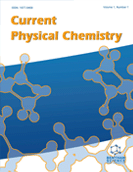Abstract
Background: Thiazoles are an important heterocycle that exhibit various bioactivities. Thiazole ring is found in the core structure of various medicinally useful compounds. It shows biological activities like anti-inflammatory, antibacterial, antifungal, antioxidant, cytotoxicity, anticonvulsant, insecticidal, anticancer and antitumor. Thioamides are reported to show bioactivities like antibacterial, antileukemia, antifungal, anti-arthritic, antimalarial and cytotoxic. Hantzsch synthesis is one of the most efficient reactions for thiazole formation, which is a cyclization reaction between thioamides and α-halo carbonyl compounds. Very few reports on the kinetic investigation of thiazole formation are available. Previously we have studied thiazole formation using 3-chloroacetylacetone and substituted thioureas by pH metric study. The reaction between 3-chloroacetylacetone and Thioamides is not reported yet. The present work deals with the kinetics and mechanistic study of ring closure of thiazole using thioamides and 3-chloroacetylacetone. The reaction was carried out in a water-ethanol system at 303 K. The kinetic investigations are carried out pH metrically. The nature of the reaction is explained on the basis of thermodynamic parameters. Reaction products are isolated and characterized on the basis of spectral data. The effect of temperature on reaction rate is studied at 30 °C to 50 °C. Thermodynamic parameters are evaluated.
Objectives: To determine the order of the reaction. To determine the rate of reaction. To evaluate the rate of reaction at various temperatures. To determine the rate of reaction in different media. To study the effect of dielectric constant, ionic strength etc. To observe calculation of the energy of activation, enthalpy of activation, entropy of activation and free energy of activation. To propose a reaction mechanism considering various thermodynamic parameters.
Methods: Measuring the change in pH, the concentration of H+ ion will be determined and accordingly, the rate of reaction will be calculated.
Results: Van’t Hoff’s differential method and the stoichiometric study suggested that one mole of Thioamides reacts with one mole of 3-chloroacetylacetone. The rates of reaction are measured at different concentrations of Thioamides at a constant concentration of 3-chloroacetylacetone. The plot of log (dc/dt) against log [3-chloroacetylacetone] and log [Thioamides] is also a straight line and the slope of the plot is nearly one with respect to both. At five different temperatures, second order rate constants are determined. The energy of activation (Ea) is determined by plotting a graph of logk versus 1/T, and other thermodynamic parameters are calculated. The negative entropy of activation (ΔS*) of this reaction specifies the rigid nature of the transition state. The entropy of activation (ΔS*) is negative and specifies that less stable noncyclic reactants convert into stable cyclic products. Free energy of activation (ΔG*) is calculated. Reacting species are oppositely charged according to the salt effect. In the water-isopropyl, alcohol system reaction is fast than water-ethanol system.
Conclusion: Using Van’t Hoff’s differential method, the rate of reaction between 3- chloroacetylacetone and Thioamides is found to be one with respect to both components; The proposed rate law also shows that the order of the reaction is two; Negative entropy (ΔS*) shows that from open chain compound, cyclic compound is formed. Nucleophilic addition and addition– elimination reactions take place; Oppositely charged species are present in the reaction; Rate increases with an increase in dielectric constant. Isopropyl alcohol-water system shows a high-rate constant as compared to that ethanol-water system.
Keywords: Ring closure, Thioamides, Order, Thiazole
Graphical Abstract
[http://dx.doi.org/10.1016/j.jiph.2020.02.002] [PMID: 32139293]
[http://dx.doi.org/10.1002/slct.201904609]
[http://dx.doi.org/10.3390/scipharm88010016]
[http://dx.doi.org/10.1002/jhet.2961]
[http://dx.doi.org/10.4155/fmc-2018-0416] [PMID: 31313595]
[http://dx.doi.org/10.1111/jcmm.12508] [PMID: 25708540]
[http://dx.doi.org/10.3390/molecules15020988] [PMID: 20335957]
[http://dx.doi.org/10.1039/tf9373301225]
[http://dx.doi.org/10.1021/j100238a002]
[http://dx.doi.org/10.1021/ed077p506]
[http://dx.doi.org/10.1021/ja01350a001]
[http://dx.doi.org/10.1111/j.1749-6632.1939.tb55380.x]
[http://dx.doi.org/10.1021/cr60035a012]
[http://dx.doi.org/10.1021/ja01185a065] [PMID: 18861802]
















